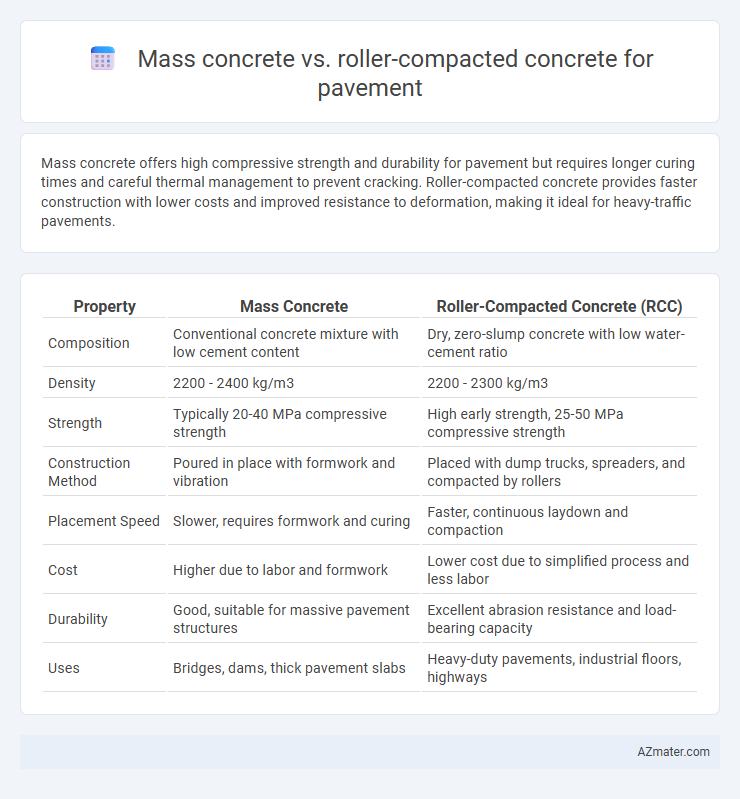Mass concrete offers high compressive strength and durability for pavement but requires longer curing times and careful thermal management to prevent cracking. Roller-compacted concrete provides faster construction with lower costs and improved resistance to deformation, making it ideal for heavy-traffic pavements.
Table of Comparison
| Property | Mass Concrete | Roller-Compacted Concrete (RCC) |
|---|---|---|
| Composition | Conventional concrete mixture with low cement content | Dry, zero-slump concrete with low water-cement ratio |
| Density | 2200 - 2400 kg/m3 | 2200 - 2300 kg/m3 |
| Strength | Typically 20-40 MPa compressive strength | High early strength, 25-50 MPa compressive strength |
| Construction Method | Poured in place with formwork and vibration | Placed with dump trucks, spreaders, and compacted by rollers |
| Placement Speed | Slower, requires formwork and curing | Faster, continuous laydown and compaction |
| Cost | Higher due to labor and formwork | Lower cost due to simplified process and less labor |
| Durability | Good, suitable for massive pavement structures | Excellent abrasion resistance and load-bearing capacity |
| Uses | Bridges, dams, thick pavement slabs | Heavy-duty pavements, industrial floors, highways |
Introduction to Mass Concrete and Roller-Compacted Concrete
Mass concrete, characterized by its large volume and minimal reinforcement, relies on its inherent weight and strength for stability in paving applications, making it suitable for heavy-duty pavements requiring high durability and load-bearing capacity. Roller-compacted concrete (RCC) is a zero-slump concrete placed with asphalt pavers and compressed by vibratory rollers, offering rapid construction and cost-effective solutions for pavement projects like industrial floors and dam surfaces. RCC combines the strength of traditional concrete with enhanced constructability, while mass concrete emphasizes thermal control and structural integrity for massive pavement structures.
Key Material Properties Comparison
Mass concrete for pavement offers high compressive strength and excellent durability due to its dense, low-permeability mix design, but it requires longer curing times and is prone to thermal cracking. Roller-compacted concrete (RCC) features a drier mix with higher aggregate content, enabling faster compaction and rapid strength gain while maintaining adequate load-bearing capacity and resistance to abrasion. RCC's lower water-to-cement ratio and improved constructability make it a cost-effective alternative for large-scale pavement projects, contrasting with the more traditional, slower-setting properties of mass concrete.
Construction Methods and Techniques
Mass concrete for pavement involves casting large volumes of concrete in place using traditional formwork and vibration techniques to ensure proper consolidation and strength. Roller-compacted concrete (RCC) uses a drier mix placed by standard asphalt paving equipment and compacted with rollers, enabling faster construction and reduced formwork needs. RCC pavements are laid in thin lifts, allowing rapid setting and early traffic opening, while mass concrete requires longer curing periods and careful thermal control to prevent cracking.
Setting Time and Workability Differences
Mass concrete for pavement exhibits longer setting times due to its high water-cement ratio and slower hydration process, offering extended workability ideal for complex placements. Roller-compacted concrete (RCC) sets rapidly with reduced water content, resulting in a stiff mix that requires mechanical compaction and offers limited workability but faster construction cycles. The choice between mass concrete and RCC hinges on balancing extended workability against expedited setting times for pavement applications.
Strength and Durability Performance
Mass concrete exhibits high compressive strength due to its dense mixture and controlled curing, making it suitable for heavy-load pavement applications with excellent long-term durability. Roller-compacted concrete (RCC) offers comparable compressive strength while providing enhanced construction speed and cost efficiency, with its layered compaction improving resistance to cracking and surface wear. Both materials achieve superior durability through low permeability and robust resistance to abrasion, freeze-thaw cycles, and chemical attack, but RCC's faster curing process often results in quicker strength gain for pavement structures.
Applications in Pavement Construction
Mass concrete is primarily used in pavement construction for heavy-duty applications such as airport runways and bridge foundations due to its high strength and durability. Roller-compacted concrete (RCC) is favored for large-scale pavement projects like highways and industrial yards because of its rapid placement, cost-effectiveness, and excellent load-bearing capacity. RCC's low slump and roller compaction method enable quicker construction timelines compared to conventional mass concrete, making it ideal for extensive pavement surfaces.
Cost and Resource Efficiency
Mass concrete typically incurs higher costs due to increased material volume and longer curing times, which demand extended labor and equipment use. Roller-compacted concrete (RCC) offers greater resource efficiency by utilizing a drier mix and faster placement techniques, reducing material waste and construction duration. The cost-effectiveness of RCC stems from lower cement content requirements and minimal finishing, making it a preferred choice for large-scale pavement projects aiming to optimize budget and resource allocation.
Curing Requirements and Practices
Mass concrete for pavement requires extended moist curing periods, typically a minimum of 7 days, to control hydration temperature and prevent thermal cracking. Roller-compacted concrete (RCC) demands shorter curing times, often 3 to 5 days, relying on surface treatments like fogging, curing compounds, or membrane covers due to its low-slump, low-water content mix. Effective curing of both types ensures optimal strength development, durability, and resistance to cracking under traffic loads.
Environmental Impact Assessment
Mass concrete for pavement typically involves higher cement content, leading to greater CO2 emissions and energy consumption during production compared to roller-compacted concrete (RCC). RCC uses less water and cement, reducing the environmental footprint by minimizing greenhouse gas emissions and resource depletion. Studies indicate that RCC's rapid placement and lower material demands significantly decrease environmental impacts in pavement construction projects.
Choosing the Right Concrete for Pavement Projects
Mass concrete offers high durability and strength, making it ideal for heavy-load pavement applications requiring long service life. Roller-compacted concrete (RCC) provides faster construction with lower costs due to its zero-slump consistency and roller compaction, suitable for large-scale industrial and highway pavements. Selecting the appropriate concrete depends on project-specific factors such as load requirements, construction speed, budget constraints, and environmental conditions.

Infographic: Mass concrete vs Roller-compacted concrete for Pavement
 azmater.com
azmater.com